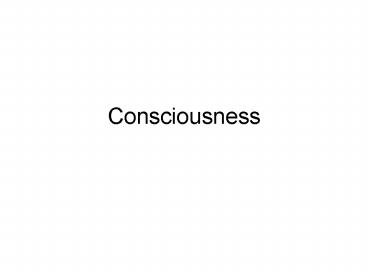Consciousness PowerPoint PPT Presentation
1 / 24
Title: Consciousness
1
Consciousness
2
Consciousness
- We are aware of ourselves
- We are aware of our actions, perceptions,
thoughts, memories, and feelings - Consciousness is the awareness of complex
processes such as, perceiving thinking, and
remembering
3
Philosophical Positions
- Not a natural phenomenon
- Something supernatural that cannot be understood
- Natural phenomenon that cannot be understood
- Nature of the human brain
- Poorly defined, not enough instruments, etc.
- Can be understood
- Just another activity of the brain
4
Most likely explanation
- Consciousness does not exist
- The ability to be conscious does
- We are not conscious of everything
- Ability to communicate provides self-awareness
- Evidence that thinking is talking in a smaller
scale (covertly)
5
Consciousness
- Are animals conscious?
- Can a computer have consciousness?
- What do you think?
6
Does thought cause action?
- Thought and action go together, but it is only a
correlation - Thought and action can both be caused by another
variable
7
Attention
- We are not conscious of all stimuli detected by
our sensory organs - Selective attention Process that controls our
awareness of particular categories of events in
the environment with exclusion of others - Divided attention Decision process of the brain
that determines how our awareness will be
apportioned to different experiences
8
Attention
- Our verbal mechanisms can contain only a limited
amount of information at one time - We cannot be aware of everything
- Selective attention determines what will be
noticed - Novelty, verbal instructions, significance
- Parts of the brain are temporarily sensitized
9
Hypnosis
- Verbal control
- Ideomotor suggestions particular action occurs
without awareness (raising arm) - Challenge suggestions particular action cannot
be performed - Cognitive suggestion Distortions of sensory
experiences - Altered activity in the verbal system
(consciousness)
10
Hypnosis
- Posthypnotic suggestibility Follows an
instruction given during hypnosis after returning
to the normal state - Posthypnotic amnesia Ignorance of what happened
during hypnosis
11
Hypnosis
- Sociocognitive approach (Spanos)
- Not a different state of consciousness
- Hypnotic behaviors are social actions that
reflect what the individual believes - Expectations play an important role
- Participation in stories
12
Hypnosis
- Dissociation approach
- Distinction between implicit and explicit memory
- Perception may occur without awareness (visual
agnosia) - Unawareness of events
- Absent minded episodes
- Intention is dissociated from actions
13
The Ponzo illusion and hypnotic blindness The
short horizontal lines are the same length. Even
when a hypnotic suggestion made the slanted lines
disappear, the visual system still perceived the
illusion
14
Uses of Hypnosis
- Can be used in Psychological treatment
- Effective tool in desensitizing phobic patients
- Relaxation
- Smoking cessation
- Pain management (endorphins are not responsible)
15
Altered States of Consciousness
- Techniques for withdrawing attention
- Meditation
- Directs attention to a single object, phrase
(mantra), sound, or movement (breathing) - Heightening of awareness and increase in
attention - Increasing consciousness or Dishabituating
16
Altered States of Consciousness
- Sleep Serves to repair the wear and tear on our
bodies caused by moving and exercising - Collect data on electrical activity of the brain
- Stage 1 Slow electrical activity similar to
awake state - Stage 2 Short bursts of electrical activity
- Stage 3 Slow waves, heart rate and breathing
slows down - Stage 4 Electrical activity increases and
sleeper climbs back up through the stages - Sleeper enters REM sleep
17
(No Transcript)
18
REM
- Rapid Eye Movement
- About every 90 minutes we enter the REM stage for
20-30 minutes, then NREM. - 4-5 cycles
- NREM no mental activity
- REM vivid cognitions and sleep paralysis
19
(No Transcript)
20
Dreams
- Psychological and Psychobiological
- Freud (1900). The interpretation of dreams
- Very influential despite lack of scientific
evidence to support it - Dreams play a role by relieving tensions
- Harmlessly fulfill a desire
- Manifest content
- Latent content symbolic meaning of the dream
21
Dreams
- Activation Syndrome Theory
- Brain trying to make sense of spontaneous bursts
of activities - Cortical activation is random
- Brain pulls together the messages by creating a
coherent story - Internal activation promotes the growth and
development of the brain - Story is influenced by culture, gender,
personality factors, and recent events
22
Sleep
- Sleep deprivation has an effect on cognitive and
motor functioning - It is required for normal brain functioning
- Sleep debt makes you stupid (Dement Vaughan,
1999, p.231)
23
Biological Clocks
- Circadian Rhythms
- Changes in activity in the hypothalamus control
daily cycles of sleep and wakefulness - Rhythms are synchronized with those of the sun
- Basic rest-activity cycle - slow wave and REM
sleep
24
(No Transcript)

